Translate this page into:
Effect of addition sesame seeds powder with different ratio on microstructural and some properties of low fat Labneh
⁎Corresponding author at: Department of Analytical Chemistry – Faculty of Applied Science, Umm Al-Qura University, Makkah, Saudi Arabia. amhameed@uqu.edu.sa (Ahmed M. Hameed),
-
Received: ,
Accepted: ,
This article was originally published by Elsevier and was migrated to Scientific Scholar after the change of Publisher.
Peer review under responsibility of King Saud University.
Abstract
Sesame seeds (Sesamum indicum L.) are probably the most ancient oil seed crops used in functional Labneh preperation. The goal of the present study was to explore the quality of Labneh made from skim milk fortified with 0%, 2%, 4%, and 6% sesame seeds powder (SSP) as alternative to fat. Control Labneh made from whole milk and their treatments with SSP were stored for 21 days at 5 ± 1 °C. The physiochemical, microbiological, and organoleptic properties were determined in fresh and stored Labneh (for 7, 14, and 21 days) as well as amino acids and microstructures were measured in fresh Labneh. The results showed that sesame seed contains up to 58.9% oil, 15.81% protein, 6.83% fiber, 11.03% carbohydrates, 14.84% antioxidant activity and 32.71 mg/100 g sesamol. The data presented that total solid, fat and acidity were increased while protein and ash contents were decreased in control Labneh compared with Labneh treatments. These all values increased with increasing the amount of SSP, except the acidity value decreased with increasing the amount of SSP. In various fresh Labneh samples, the major essential amino acid was Leucine and non-essential amino acid was Glutamic than the other amino acids. Microbiological examination of Labneh revealed that the total bacterial counts increased throughout the storage period. However moulds and yeasts were not detected at the first week then slightly detected and increased at the end of storage period. Coliform bacteria and spore-forming bacteria didn't observe in all Labneh treatments as storage progressed. Scanning electron microscopy showed that the control Labneh samples had more compact structure and fusion into big aggregates without voids. Labneh made from skim milk had numerous open, loose and less dense protein networks with spaces. No major differences were observed in the Labneh made from skim milk using 2% and 4% sesame seeds . Labneh made from skim milk using 6% sesame seeds was more intensive and thicker casein matrix than the other Labneh treatments. Organoleptic scores revealed that Labneh fortified with 4% sesame seeds powder have the highest acceptability properties.
Keywords
Low fat Labneh
Sesame seeds
Sesamol
Physicochemical
Amino acids
Microbiological
Microstructure
Organoleptic properties
1 Introduction
Sesame (Sesamum indicum L.) is foremost grown for its edible seeds and oil. It is used about 65% with regard to oil extraction and 35% with regard to food. Sesame seeds have many health benefits are due to its nutritional content, including fibers, vitamins, minerals, natural oils and organic compounds (Singh et al., 2016). Range of chemical composition of sesame was within limits 50–60% oil, 18–25% protein, 13.5% carbohydrate and 5% ash (Elleuch et al., 2007). Sesame seed is a rich food of essential amino acids, essential fatty acids, tocopherols, and phenolic compounds comprise sesamol, sesamolin, and furaneol have high antioxidants activity (Moazzami and Kamal-Eldin, 2006, and Ali et al., 2007). Sesame seeds are too an infinitive of omega-6, vitamin E and are the great source of calcium that contains far more calcium than in the dairy products (Singh et al., 2016). The seeds of this crop have a high polyunsaturated fatty acid (85%) as follows, linoleic acid (37–42%) and oleic acid (41–45%) (Kim et al., 2006). Sesame is one of the rich sources of phytosterols which are groups of steroid alcohols and esters had the health benefits to lower total and LDL blood cholesterol by barring cholesterol absorption from the intestine (Abilasha et al., 2016). Join these benefits help in digestion stimulates blood circulation and the nervous system; protect our body from free radicals, inhibits colon cancer, and improve heart health and liver from oxidative damage. Proceeding from these benefits, sesame seeds are much appreciated in bakery, candy industry and other food specialties as snacks, cookies, and fermented food like soybean and peanut, sesame seed can be processed to make sesame milk (Hansen, 2011; Fitrotin et al., 2015). African countries use the seeds as spice, seed oil, frying vegetables and meat, eaten raw or fried and used in confections such as candy and baking (Anilakumar et al., 2010).
Labneh is a concentrated yoghurt, produced by removing part of yoghurt whey, giving it a consistency between yoghurt and cheese that reportedly include 22–26% total solids and 8–11% fat with typical acidity and pH values among from 1.4 to 2.5 and 3.86 to 4.17, respectively (El-Samragy, 1997). It should be a white to creamy paste that has a smooth texture, with a taste crossing between sour cream and cottage cheese and a characteristic sharp flavor that is largely modulated by diacetyl produced during fermentation and it is a popular food in various parts of the world especially in the Balkan, Turkey and Middle East regions where it plays a significant role in the family diet (Tamime and Robinson, 1999). Fresh Labneh is stored in the refrigerator and consumed within two weeks. Sometimes it is stored in vegetable oil at room temperature and consumed within two years (Keceli, et al. 1999). Fat and oil may improve overall food palatability, flavor and mouth feel but elevated fat diet is dejected because of potential diet connected diseases such as obesity, coronary heart disease, cancer and high blood cholesterol (Nateghi et al., 2012). Labneh with sesame seeds powder might be considered a low-fat food, high acceptability, good for reducing risk factors of cardiovascular diseases and prevent the growth and activity of dangerous microorganisms without affecting in the growth and activities of starter used in manufacture. Therefore, the objectives of this study were to develop innovation low fat Labneh fortified with sesame seeds powder as alternative to fat and their effect on physicochemical, microbiological, microstructure, and sensory properties of fresh Labneh product and during cold storage.
2 Materials and methods
2.1 Materials
Fresh cow's milk was obtained from private from the experiential center of the Dairy Department, Faculty of Agriculture Mansoura University, Egypt and skimmed by separate the cream to get skim milk. Lypholized yoghurt starter culture (Streptococcus thermophilus and Lactobacillus delbrueckii subsp. bulgaricus) was obtained from Ch. Hansen’s Laboratories, Denmark. Salt (sodium chloride) and sesame seeds were purchased from Mansoura City market (Egypt). In this study, all chemicals were an analytical grade and purchased from Sigma Chemical Co. (St. Louis, MO).
2.2 Methods
2.2.1 Sesame seeds powder preparation
Decorticated sesame seed and characterized as sweet sesame were used. Sesame seed were cleaned by handpicking and winnowing to remove foreign matter following washed, air dried in oven at 25–30 °C, before ground using a Moulinex mill grinder (Type 320, made in EC) and then sieved to obtain fine powder and stored in a glass container.
2.2.2 Labneh preparation
Labneh was made approving to Robinson and Tamime (1994).Fresh whole cow’s milk (3% fat) and skim (0.67% fat) were heated at 90 °C for 20 min directly, cooled to 45 °C and then inoculated with 2% of the yoghurt starter culture (S. thermophilus + L. bulgaricus) and incubated at 42 °C for 3 h until it was completely coagulated. Thus yoghurt were cooled to 5 °C and stored overnight and then mixed with 2% of sodium chloride. The mixes put into cheese cloth bags, which were hanged in the refrigerator room at 5 °C for 18 h, to permit drainage of the whey. The resulting Labneh was made from cow milk (3% fat) served as control and Labneh was made from skim milk divided into four treatments were mixing with sesame seeds powder at ratios 0. 2, 4 and 6% as called T1, T2, T3 and T4 respectively. The fresh Labneh samples were pack into small plastic jar and stored for 21 days at 5 ± 1 °C. Samples were taken for analysis when fresh and after 7, 14, and 21 days during the cold storage.
2.2.3 Physiochemical analyses
The total solids, protein, fat, ash and acidity content (as % lactic acid) were determined according to AOAC (2000). The carbohydrate content was calculated by difference. The pH value of Labneh was directly measured using a digital pH meter (Electronics Corporation of India). Antioxidant activity was determined by (DPPH) method as described by Lee et al. (2003).
2.2.4 Determination sesamol of sesame seeds for HPLC
Sesame seeds samples were ground in a grinder for 5 min. then, 10 mg of grinded sample were added to 20 mL hexane and shacked for 5 min. then centrifuged at 13000 rpm / min for 5.0 min. and separated the filtrate. Samples were filtered through PTFE (0.45 µm) membrane syringe filters. HPLC analysis was carried out according to Aly (2012) in a Thermo scientific system (Chromeleon 7.2) with LPG-3400SD model pump, with a 20 μL sample loop by autosampler (WPS-3000SL), diode array detector (DAD-3000). The analysis was carried out using Column compartment (Ulti Mate 3000). Thermo scientific part No 28105-254630 BDS HYPERSIL C18 (Dim. 250 × 4.6 mm) was used for analysis. The mobile phase used was methanol: water (60:40, v/v) with a flow rate of 0.6 mL/min. The UV–Visible detector was set at 290 nm. 2.6. Statistical analysis three different replicate trials were conducted in this study.
2.2.5 Amino acid composition
Samples and standards are then analyzed using a Beckman 6300 system according to the official standard method (AOAC, 2005).
2.2.6 Microbiological analysis
Total bacteria count, coliforms bacteria, spore-forming bacteria and yeasts and molds, were computed according to standard procedures (Marshall, 1992).
2.2.7 Electron Microscopy of Labneh
The Electron Microscopic analyzed according to Ismail and Tammam, 2015). Samples were freeze-fractured in liquid nitrogen to approximately 1mm pieces and these pieces were then mounted on aluminum stubs with silver paint, dried to critical point and coated with gold for 300 Å in a Sputter- Coater (SCD 005 Sputter Coater) and using SEM (FEI Company, Netherlands) Model Quanta 250 FEG (Field Emission Gun) attached with EDX Unit (Energy Dispersive X-ray Analyses), with accelerating voltage 20 K.V. under low vacuum condition with pressure chambers 60 Pa.
2.2.8 Organoleptic properties
According to score card suggested by Scott (1981) organoleptically scored of Labneh were involve flavour (50 points), body and texture (35 points), and appearance (15 points) when fresh and after 7, 14 and 21 days of refrigerator storage at (5 ± 1 °C) by staff members of the Dairy Science Department, Faculty of Agriculture Mansoura University, Egypt.
2.2.9 Statistical analysis
Using SPSS software (version 20) the data were analyzed statistically. The results were expressed as mean ± SD of triplicate and the statistical analysis per formed using one-way analysis of variance followed by Duncan tests. The level of significance was preset at P ≤ 0.05.
3 Results and discussion
3.1 Chemical composition of sesame seeds
Chemical constituent of sesame seeds used to produce low fat Labneh was given in Table 1. The results show that moisture, lipids, crude protein, carbohydrate, fiber, and ash contents for sesame seeds were 4.6, 58.9, 15.81, 11.03, 6.83 and 2.63% respectively. Similar results agreement with Sharma et al. (2015) and Singh et al. (2016). These results are a line with Nzikou et al., (2009) and Makinde and Akinoso (2014) they showed that the sesame seeds contained 5.7% and 4.81% for moisture, 54% and 47.73% for fat, 20% and 26.79% for proteins, 13.4% and 9.65% for carbohydrate, 3.7% and 6.62% for crude fiber and 3.2% and 4.62% % for ash, respectively. The variation in moisture, lipids, protein, fiber, and ash content could be due to climatic conditions, maturity of plant and variety as well as analytical methods variation. The nutrient, particularly crude protein and fibercontents of sesame seed were very high to warrant their consideration for use to complement cereal-based products to meet the recommended daily nutrient intake of human (National Research Council, 1989). Means ± standard deviation (SD).
Some chemical constituent
Sesame seeds
Moisture (%)
4.6 ± 0.12
Total lipids (%)
58.9 ± 0.31
Crud protein (%)
15.81 ± 1.63
Total carbohydrates (%)
11.03 ± 0.23
Fiber (%)
6.83 ± 1.42
Ash (%)
2.63 ± 1.12
Sesamol (mg/100 g sesame seeds)
32.71 ± 0.24
Antioxidants activity by DPPH radical (%)
14.84 ± 0.46
It could be seen from Table 1 and Figs. 1 and 2 that sesame seeds contained high levels from sesamol and antioxidants activity (32.71 mg/100 g and 14.84%, respectively). Sesame is a source of natural antioxidant like sesamolin, sesamin and sesamol tocopherols and is extensively used as nutritional supplement. It may be used for prevention of several diseases such as cancer and cardiovascular diseases. Similar results were reported by (Namiki, 2007). Sesamol is also produced from the degradation of sesamolin during the roasting process of sesame seeds, so sesamol could not be discovered in the unroasted seed oil (Yoshida and Takagi, 1997). Sesamol is a strong phenolic antioxidant. This shows that sesame has a role of health benefits in controlling blood pressure, lowering cholesterol, and dermatological disease management (Nagendra Prasad et al., 2012). Consequently the seeds can be easily combined into a normal diet at a level that might benefit health as a natural antioxidant with wide food-related applications.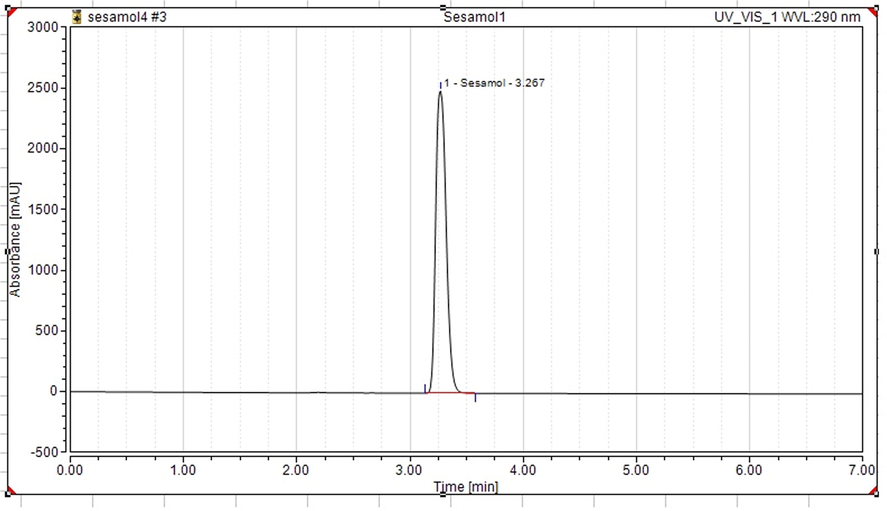
HPLC chromatograph of standard of sesamol (250 ppm) at 25 °C, methanol: water (60:40, v/v) as mobile phase and using Diode Array Detector (290 nm).
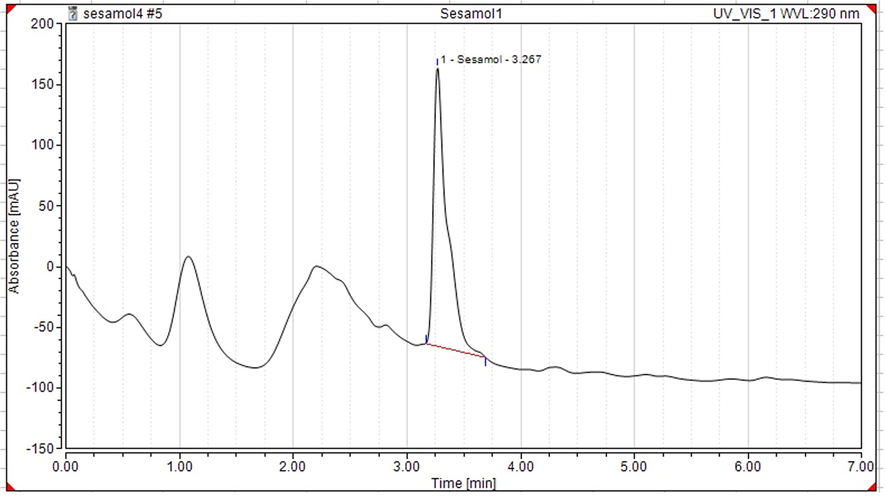
HPLC chromatograph of extracted sesame seeds for determination of sesamol at 25 °C, methanol:water (60:40, v/v) as mobile phase and using Diode Array Detector (290 nm).
3.2 Physiochemical of Labneh
The changes in chemical properties of fresh Labneh and throughout storage period were summarized in Fig. 3. Total solids (TS) and fat of control Labneh made from whole cow milk was significantly (p ≤ 0.05) higher than that of Labneh made from skim milk without and within sesame seeds. TS and fat contents markedly increased with increased sesame seeds levels and it is increased slightly in all Labneh samples as the throughout storage time. Throughout storage, TS and fat content increased could be ascribed to moisture loss. The data is similar those of Ismail et al. (2016).The protein and ash contents of control Labneh was found to be the lowest compared with all treatments. The percentage of protein and ash increased with increased the levels of sesame seeds added and during the storage period in Labneh samples. There is no significant differences (P ≥ 0.05) were observed in protein and ash contents of the different Labneh either fresh or after the storage period. Shelf life of Labneh depends on acidity value. In overall the acidity values of control Labneh significantly higher than Labneh made from skim milk within and without sesame seeds. Labneh treatment with 2% sesame seeds powder had the highest acidity values, indicative of an increase in acid-producing microorganisms. These results were in agreement with that obtained by Abou Dawood (2002). The acidity values for the entire Labneh samples were similar. As the storage period advanced the acidity in all Labneh increased gradually with a slow rate. Increase of the acidity values may be due to the hydrolysis of lactose by microorganisms that responsible for the increasing of acidity as a result of the production of organic acids (e.g. lactic acid). Similar findings were reported for Hashim et al. (2009). Generally, total solids, fat, protein, ash and acidity values were in accordance with those reported by Romeih et al. (2014), they reported that protein and ash contents increased in yoghourt made from skim milk but, total solids, fat and acidity increased in yoghourt made from whole milk.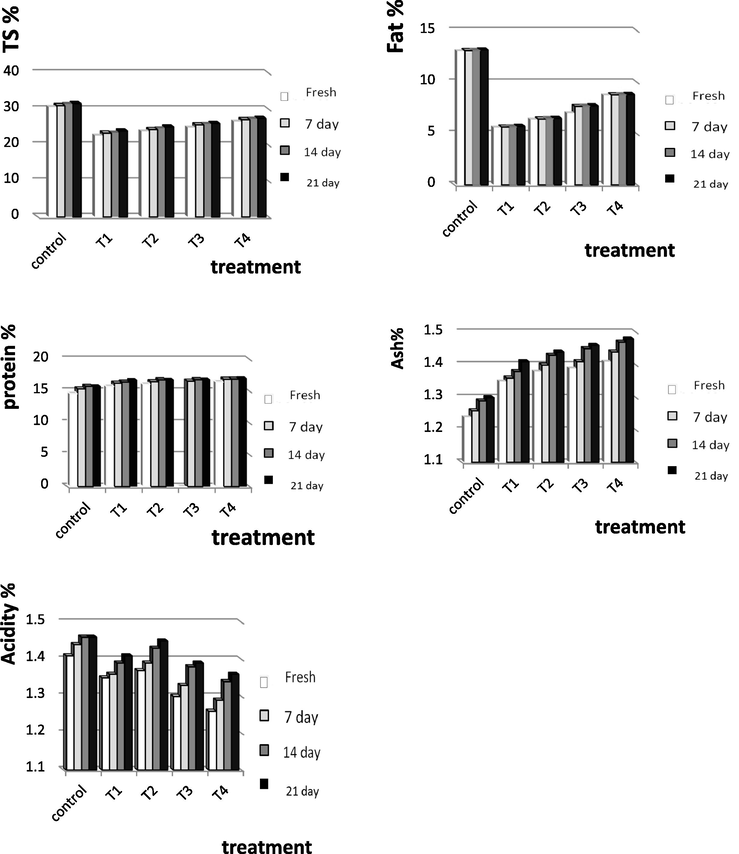
Effect of adding of sesame seeds powder on physicochemical properties of fresh Labneh and throughout storage period. Control, Labneh made from whole milk; T1, Labneh made from skim milk; T2, Labneh made from skim milk with 2% sesame seeds; T3, Labneh made from skim milk with 4% sesame seeds; T4, Labneh made from skim milk with 6% sesame seeds.
3.3 Amino acids
The effect of different ratio of sesame seeds added on total amino acids (Essential and non-essential) content of fresh Labneh treatments is shown in Table 2 and Fig. 4. In various Labneh samples, the major essential amino acid was Leucine after that lysine but, Histidine content was the lowest. On the other hand non-essential amino acids were Glutamic acid had the highest followed by Proline and Aspartic acid; on the contrary, Cystine had the lowest content than the other amino acids. These results are in line with those reported by El-Sayed et al. (2016), when making kareish cheese with added sesame hulls. As differences of amino acids contents were detected for the different Labneh treatments using sesame seeds. Nature and quantity of free amino acids probably development of Labneh flavous. A similar trend was reported by (Omar. 2012). In different Labneh experiments, the highest level of total free amino acids was that of glutamic acid, which is answerable for protection from cardiovascular diseases, after that aspartic acid. Generally, glutamic and Lysine were dominant in different Labneh trials. Control: Labneh made from whole milk. T1: Labneh made from skim milk. T2: Labneh made from skim milk with 2% sesame seeds. T3: Labneh made from skim milk with 4% sesame seeds. T4: Labneh made from skim milk with 6% sesame seeds.
Amino acids (%)
Control
T1
T2
T3
T4
Essential amino acids (AA)
Therionine
(Thr)
0.76
0.76
0.74
0.75
0.72
Valine
(Val)
0.98
1.03
0.99
0.96
0.95
Methionine
(Met)
0.63
0.62
0.57
0.59
0.60
Isoleucine
(Ile)
0.92
0.92
0.87
0.89
0.88
Leucine
(Leu)
1.57
1.57
1.59
1.63
1.58
Tyrosine
(Tyr)
0.75
0.74
0.71
0.82
0.74
Phenyalanine
(Phe)
0.92
0.80
0.87
0.89
0.89
Lysine
(Lys)
1.40
1.41
1.34
1.31
1.28
Histidine
(His)
0.54
0.51
0.49
0.51
0.50
Total essential amino acids
8.47
8.36
8.17
8.35
8.14
Non-essential amino acids
Aspartic
(Asp)
1.25
1.23
1.23
1.27
1.26
Serine
(Ser)
0.96
0.86
0.87
0.85
0.81
Glutamic
(Glu)
3.35
3.64
3.06
3.44
3.41
Proline
(Pro)
1.98
2.01
1.93
1.96
1.67
Glycine
(Gly)
0.32
0.32
0.33
0.37
0.38
Alanine
(Ala)
0.55
0.51
0.53
0.56
0.59
Cystine
(Cys)
0.24
0.28
0.31
0.29
0.41
Arginine
(Arg)
0.59
0.57
0.59
0.67
0.72
Total non-essential amino acids
9.24
9.24
8.85
9.41
9.25
Total amino acid
17.71
17.71
17.02
17.76
17.39
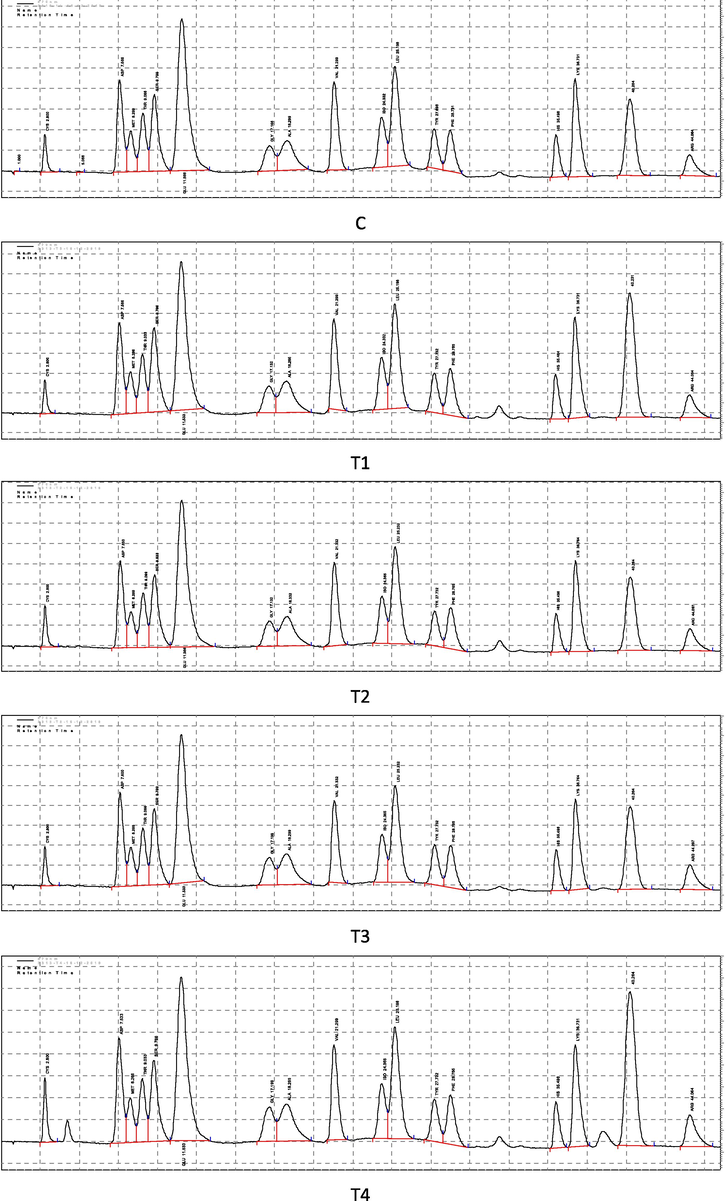
Effect of adding of sesame seeds powder on amino acid contents of fresh Labneh and throughout storage period: Control, Labneh made from whole milk; T1, Labneh made from skim milk; T2, Labneh made from skim milk with 2% sesame seeds; T3, Labneh made from skim milk with 4% sesame seeds; T4, Labneh made from skim milk with 6% sesame seeds.
3.4 Bacterial counts in Labneh
Analysis of the results obtained for the total bacteria counts, coliform bacteria, spore-forming bacteria and yeast & mould (Table 3). The results obtained for the total bacterial counts (TBC) in all Labneh increased gradually up to end of storage period. These findings are in approval with those of Hamad et al. (2014), they reported that TBC for all Labneh samples fortification with whey protein increased throughout refrigerated storage. Labneh made from whole milk had the highest TBC at zero time and at the end of storage period as comparison with other Labneh made from skim milk untreated and that using sesame seeds. This may be due to reflects that high fat and protein contents in the first Labneh represent a good protection background for microorganisms which naturalizes the inhibitory effect of antimicrobial substances (Aureli, et al., 1992). However, Labneh made with 2% of sesame seeds had the highest count while, Labneh made with 6% of sesame seeds had the lowest count. The obtained results suggest that the bacterial populations were inhibited by sesame seeds. This agrees with Fitrotin et al. (2015) they reported that the free sesaminol aglycon exhibit a higher reactivity in scavenging radicals, resulted in a higher antioxidant activity are primarily responsible for their antimicrobial properties. Obviously, coliform bacteria and spore-forming bacteria were negative in any of the Labneh samples. This might be due to the efficient heat treatment of milk (90 °C for 20 min) and high hygienic condition during manufacture and storage, the obtained results agreed with Ammara (2000). The quality and the shelf life of Labneh evaluated with yeasts and moulds counts. No moulds and yeasts growth was detected in different fresh Labneh, but they appeared after 7 days and increased up till the end of storage. The counts of yeast and mould of control Labneh made from whole milk higher than that in other Labneh treatments until the end of storage. These results may be due to increase the acidity which paved the conditions to grow these organisms. These results are sure with the previous results reported by Abou Ayana and Ibraham (2015). Control: Labneh made from whole milk. T1: Labneh made from skim milk. T2: Labneh made from skim milk with 2% sesame seeds. T3: Labneh made from skim milk with 4% sesame seeds. T4: Labneh made from skim milk with 6% sesame seeds. a, b, c: Means ± SD with same letter among treatments in the same storage period. A, B, C: Means ± SD with same letter for same treatment during storage period.
Microbial groups
Storage period (Days)
Control
T1
T2
T3
T4
Total bacterial count
Fresh
10.67 ± 1.15aB
8.33 ± 1.53bC
6.33 ± 0.58cC
6.00 ± 1.00cdB
4.33 ± 0.58 dB
7
11.00 ± 1.00aB
10.33 ± 1.53abBC
8.67 ± 0.58bB
6.00 ± 1.00cB
5.67 ± 0.58cB
14
14.00 ± 1.00aB
13.33 ± 1.53aB
10.00 ± 1.00bB
6.67 ± 1.53cB
6.00 ± 1.00cB
21
23.00 ± 3.00aA
22.00 ± 2.00aA
16.67 ± 2.08bA
15.33 ± 3.06bcA
11.67 ± 2.08cA
Spore-forming bacteria
Fresh
ND
ND
ND
ND
ND
7
ND
ND
ND
ND
ND
14
ND
ND
ND
ND
ND
21
ND
ND
ND
ND
ND
Coliform bacteria
Fresh
ND
ND
ND
ND
ND
7
ND
ND
ND
ND
ND
14
ND
ND
ND
ND
ND
21
ND
ND
ND
ND
ND
Molds & yeasts
fresh
0.00 ± 0.00
0.00 ± 0.00
0.00 ± 0.00
0.00 ± 0.00
0.00 ± 0.00
7
4.67 ± 0.11aC
3.00 ± 0.21bC
2.33 ± 0.12cC
0.00 ± 0.00dC
0.00 ± 0.00dC
14
5.67 ± 0.23aB
4.67 ± 0.30bB
2.67 ± 0.24cB
1.33 ± 0.10dB
1.00 ± 0.03dB
21
16.00 ± 0.12aA
11.33 ± 0.05bA
5.00 ± 0.13cA
2.00 ± 0.04dA
1.33 ± 0.11eA
3.5 Labneh microstructure
Microstructure has a major impact on the texture and other physical properties of Labneh. Microstructures of fresh control Labneh and that is using sesame seeds were examined by electron microscopy (ESM) fined in Fig. 5. At control Labneh made from whole milk (C) appeared to have a compact protein matrix and fusion structure than other Labneh trails. This probably due to the higher number of fat globules acting as linking protein agents. Otherwise, control Labneh shows the existence of individual micelles in a spherical shape. The image of control Labneh reveals a protein aggregation and protein network as homogeneous. These results were similar to those reported by Attia et al., (2001). However, Labneh made from skim milk (T1) had protein structure was a short casein micelles chain no fusion like sponge with irregular cluster cells. Furthermore, extra open, loose and less dense protein network contain large space than control Labneh. It is, therefore, concluded that the separate particles seen in the skim milk could be broken protein aggregates and broken or ripped-off casein strands on account of separate process. In Labneh using sesame seeds, the casein micelles were attachment in chains with comparatively few interspaced voids. Micrographs of Labneh (T2) and (T3) looked similar in size of casein clusters and protein aggregates. Moreover, SEM revealed that the protein matrices of Labneh samples with increase sesame seeds levels appeared to be relatively more intensive and particle fusion into big aggregates rather than Labneh made from skim milk alone. Wherefore, casein clusters were thicker in the Labneh treated (T4), perhaps as a result of sesame seeds powder.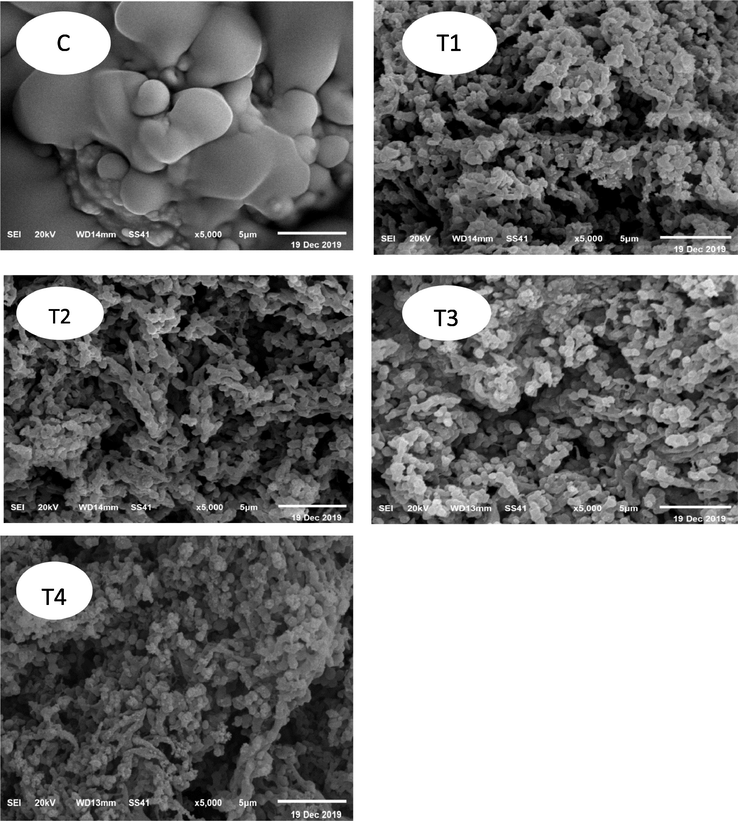
SEM micrograph of fresh Labneh: Control, Labneh made from whole milk; T1, Labneh made from skim milk; T2, Labneh made from skim milk with 2% sesame seeds; T3, Labneh made from skim milk with 4% sesame seeds; T4, Labneh made from skim milk with 6% sesame seeds.
3.6 Organoleptic properties of Labneh
Organoleptic properties of food products are one of the most important factors in accepting and choosing them for consumption. In general, Labneh can be described by a white color, a soft and smooth body, a good spreadability and a few acidic flavors (Nsabimana et al., 2005). Fig. 6 shows the results of the evaluation of the Labneh made from whole milk and Labneh made from skim milk without or within sesame seeds powder allover storage period. It is exhibited that the Labneh made from whole milk had higher (P ≤ 0.05) perceived appearance, flavor, texture and overall acceptability among all experimental Labneh made from skim milk alone and within sesame seeds. With respect to the flavor of Labneh made from skim milk recorded the lowest value as compared to other Labneh. Nevertheless, added sesame seeds had significant effect (P ≤ 0.05) on the organoleptic parameters evaluated in this study. The degree of acceptable increase with increases the levels of sesame seeds. Labneh samples that were produced with 4% gained the highest scores from flavor and texture point followed by with 2% sesame seeds powder when, compared with other Labneh treatments. When the content of sesame seeds powder was increased, the acceptability of the product was decreased as compared with control. The obtained results are similar to those reported by Hashempour-Baltork et al. (2018) they found sensory evaluation of puffed corn snack with 5% and 10% sesame powder had the highest score from flavor and aroma point. However the greatest percentage of sesame gives a definite odor to commercial cookies, especially the cookies with 20% sesame as well as for bread supplemented with up to 10% sesame (Hernández-Monzón et al., 2014; Mohamed, 2018). The organoleptic properties of the different Labneh samples slightly increased and gradually during storage tell 14 days, and then the acceptability of all samples gradually decreased as the storage period progressed. These results are in agreement with (Salem et al., 2007).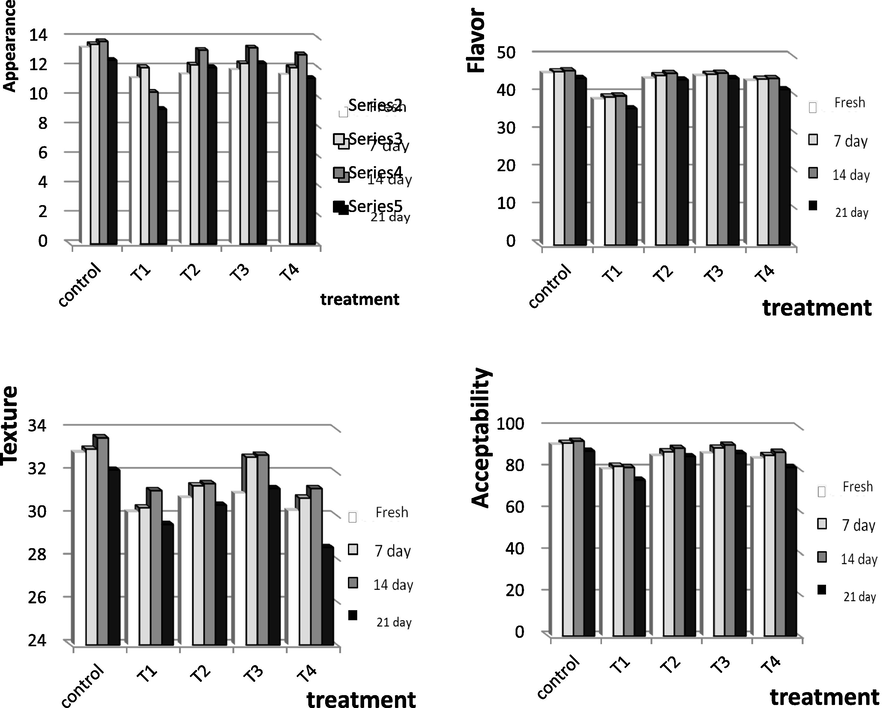
Effect of adding of sesame seeds powder on organoleptic properties of fresh Labneh and throughout storage period: Control, Labneh made from whole milk; T1, Labneh made from skim milk; T2, Labneh made from skim milk with 2% sesame seeds; T3, Labneh made from skim milk with 4% sesame seeds; T4, Labneh made from skim milk with 6% sesame seeds.
4 Conclusion
In our attempts to utilize decorticated sesame seed in production of low fat Labneh when additives with skim milk lead to increase the content of Labneh fat, protein and ash. These additives also reduced microbial counts and improved Labneh microstructure quality and developed the organoleptic properties especially the appearance, flavor and texture. Generally speaking, it could be recommended that adding 4 % sesame seeds powder in making Labneh had the greatest overall acceptability, but higher levels of sesame powder applied resulted in reduced product acceptability.
Acknowledgements
The authors are grateful to Benha, New Valley, and Mansoura University, Egypt. Also, Faculty of Applied Sciences, Umm Al-Qura University, 21955 Makkah, Saudi Arabia.
Declaration of Competing Interest
The authors declare that they have no known competing financial interests or personal relationships that could have appeared to influence the work reported in this paper.
References
- Evaluation of phytosterol in sesame seed oil and study its effects on fermented dairy product. Euro. J. Food Sci. Technol.. 2016;4(1):10-17.
- [Google Scholar]
- Attributes of low- fat yogourt and Kareish cheese made using exopolysaccharides producing lactic acid bacteria. Am. J. Food Technol.. 2015;10(1):48-57.
- [Google Scholar]
- Sensitivity of yeast flora of labneh to spices. Egypt. J. Dairy Sci.. 2002;30:35-42.
- [Google Scholar]
- Assessment of genetic diversity in sesame (Sesamum indicum L.) detected by amplified fragment length polymorphism markers. Electron. J. Biotechnol.. 2007;10:12-23.
- [Google Scholar]
- Effect of gamma irradiation on sesamol contents in sesame seeds and their coats. Isotope Radiat. Res.. 2012;44(2):463-476.
- [Google Scholar]
- Studies on use of bifidobacteria in manufacture some dairy products. Cairo, Egypt: Faculty of Agriculture, Ain Shams University; 2000. M.Sc. Thesis
- Nutritional, medicinal and industrial uses of Sesame (Sesamum indicum L.) seeds. Agric. Conspectus Sci.. 2010;75(4):159-168.
- [Google Scholar]
- Association of Official Analytical Chemists. Official Methods of Analysis (17th ed.). Washington, DC, USA: AOAC; 2000.
- Official Methods of Analysis of Association of Official Analytical Chemist International. Washington (D.C.): AOAC; 2005.
- Dromedary milk lactic acid fermentation: microbiological and rheological characteristics. J. Ind. Microbiol. Biotechnol.. 2001;26:263-270.
- [Google Scholar]
- Antimicrobial activity of some plant essential oils against Listeria monocytogenes. J. Food Prot.. 1992;55:344-348.
- [Google Scholar]
- Quality characteristics of sesame seeds and by-products. Food Chem.. 2007;103:641-650.
- [Google Scholar]
- Making kareish cheese with high with added sesame hulls. J. Food Dairy Sci., Mansoura Univ.. 2016;7(2):97-105.
- [Google Scholar]
- Antioxidant properties of fermented Sesame milk using Lactobacillus plantarum Dad 13. Int. Res. J. Biol. Sci.. 2015;4(6):56-61.
- [Google Scholar]
- Effect of fortification with whey protein on the chemical, microbial and organoleptical properties of labneh. J. Food and Dairy Sci. Mansoura Univ.. 2014;5(11):751-762.
- [Google Scholar]
- Sesame. Ag MRC. USA: Iowa State University; 2011.
- Quality properties of puffed corn snacks incorporated with sesame seed powder. Food Sci. Nut.. 2018;6(1):85-93.
- [Google Scholar]
- Quality and acceptability of a set-type yogurt made from camel milk. J. Dairy Sci.. 2009;92:857-862.
- [Google Scholar]
- Develop of a sweet cookie with toasted sesame and ground. Tecnología Química. 2014;34(3):240-250.
- [Google Scholar]
- Physicochemical, microbiological quality and organoleptic properties of yoghurt supplemented with linseed oil. J. Food Dairy Sci., Mansoura Univ.. 2016;7(7):315-321.
- [Google Scholar]
- The role of olive oil in the preservation of yogurt cheese (Labneh Anbaris) Int. J. Dairy Technol.. 1999;52:68-72.
- [Google Scholar]
- Determination of sesamin and sesamolin in sesame (Sesamum indicum L.) seeds using UV spectrophotometer and HPLC. Korean J. Crop. Sci.. 2006;51(1):95-100.
- [Google Scholar]
- Effect of far infrared radiation on the antioxidant activity of rice hulls. J. Agric. Food Chem.. 2003;51:4400-4403.
- [Google Scholar]
- Comparison between the nutritional quality of flour obtained from raw, roasted and fermented sesame (Sesamum indicum L.) seed grown in Nigeria. Acta Sci. Pol., Technol. Aliment.. 2014;13(3):309-319.
- [Google Scholar]
- Standard Methods for the Examination of Dairy Products. Washington, DC: American Public Health Association; 1992.
- Sesame seed is a rich source of dietary lignans. J. Am. Oil Chem. Soc.. 2006;83:719-723.
- [Google Scholar]
- Quality of bread fortified with different levels of groundnut and sesame flour. Sudan: College of Agriculture Studies, Sudan University of Science and Technology; 2018. M.Sc. Thesis
- A Review on nutritional and nutraceutical properties of Sesame. J. Nut. Food Sci.. 2012;2(2):1-6.
- [Google Scholar]
- Nutraceutical functions of sesame: a review. Rev. Food Sci. Nut.. 2007;47(7):651-673.
- [Google Scholar]
- Optimization of textural properties and formulation of reduced fat Cheddar cheeses containing fat replacers. J. Food Agric. Environ.. 2012;10(2):46-54.
- [Google Scholar]
- Recommended Dietary Allowance (11th ed.). Washington DC: National Academy Press; 1989.
- Manufacturing, properties and shelf life of labneh: a review. Int. J. Dairy Technol.. 2005;58(3):129-137.
- [Google Scholar]
- Chemical composition on the seeds and oil of sesame (Sesamum indicum L.) grown in Congo-Brazzaville. Adv. J. Food Sci. and Technol.. 2009;1(1):6-11.
- [Google Scholar]
- Microstructure of semi hard type cheese made from reconstituted whole milk powder. Egypt. J. Dairy Sci.. 2012;40:45-89.
- [Google Scholar]
- Manufacture of yogurt and other fermented milks. In: Robinson R.K., ed. Modern Dairy Technology, Advances in Milk Products. Vol 2. London: Elsevier Applied Science; 1994. p. :1-48.
- [Google Scholar]
- The addition of buttermilk powder and transglutaminase improves textural and organoleptic properties of fat-free buffalo yogurt. Dairy Sci. Technol.. 2014;94(3):297-309.
- [Google Scholar]
- Use of synbiotics for production of functional low fat labneh. Pol. J. Food Nut. Sci.. 2007;57(2):151-159.
- [Google Scholar]
- Cheese making Practice. London, UK: Applied Science Publishers Ltd.; 1981. ISBN-13: 9780853349273, Page: 475
- Sesamum indicum before and during pregnancy: a review. Int. J. Res. Dev. Pharm. Life Sci.. 2015;4(5):1750-1759.
- [Google Scholar]
- Benefits and nutritive value of sesame seed. In. J. Recent Sci. Res.. 2016;7(9):13245-13247.
- [Google Scholar]
- Yoghurt Science and Technology (second ed.). Boca Raton, FL: CRC Press; 1999.
- Effects of seed roasting temperature and time on the quality characteristics of sesame oil. J. Sci. Food Agric.. 1997;75:19-26.
- [Google Scholar]







